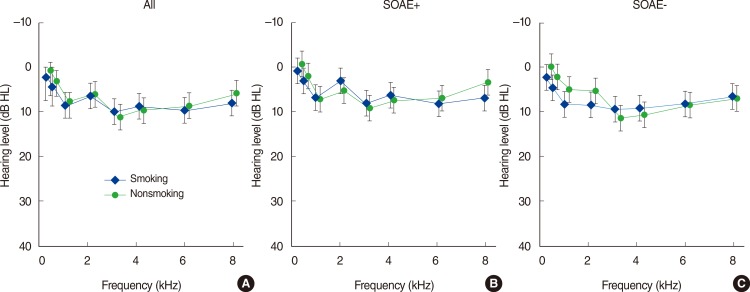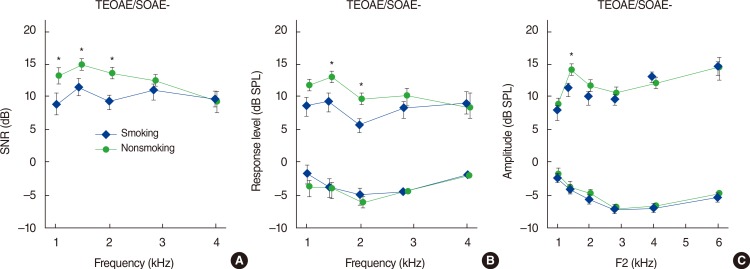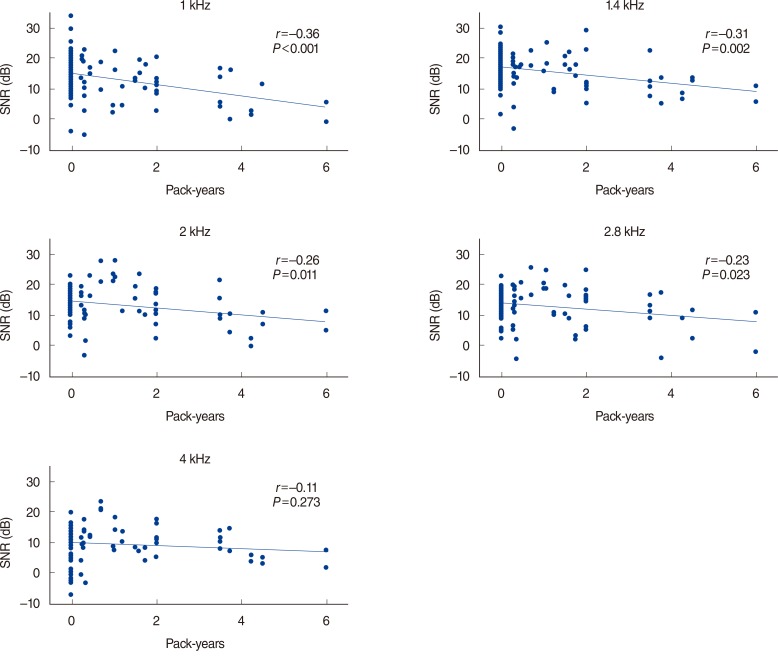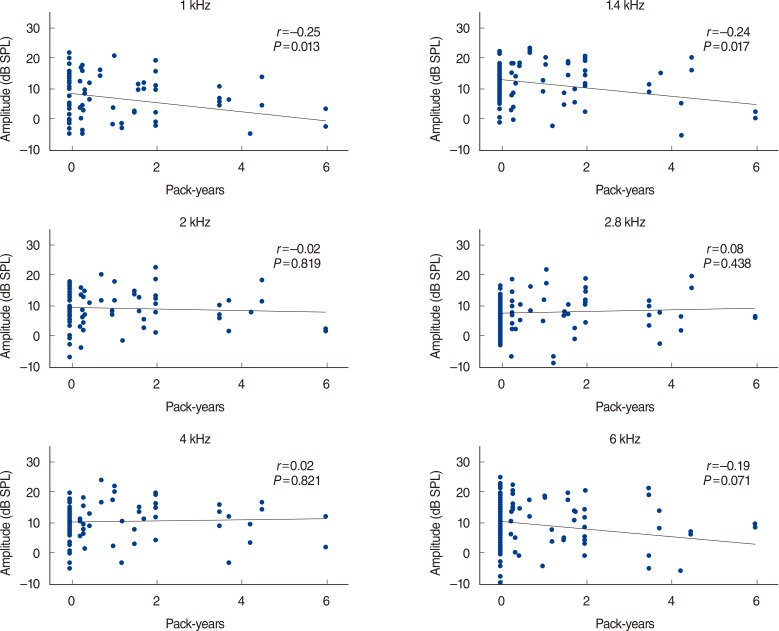1. Jha P, Ranson MK, Nguyen SN, Yach D. Estimates of global and regional smoking prevalence in 1995, by age and sex. Am J Public Health. 2002; 6. 92(6):1002–1006. PMID:
12036796.

2. Ambrose JA, Barua RS. The pathophysiology of cigarette smoking and cardiovascular disease: an update. J Am Coll Cardiol. 2004; 5. 43(10):1731–1737. PMID:
15145091.
3. Shargorodsky J, Curhan SG, Henderson E, Eavey R, Curhan GC. Heavy metals exposure and hearing loss in US adolescents. Arch Otolaryngol Head Neck Surg. 2011; 12. 137(12):1183–1189. PMID:
22183895.

4. Rybak LP. Hearing: the effects of chemicals. Otolaryngol Head Neck Surg. 1992; 6. 106(6):677–686. PMID:
1608633.

5. Cruickshanks KJ, Klein R, Klein BE, Wiley TL, Nondahl DM, Tweed TS. Cigarette smoking and hearing loss: the epidemiology of hearing loss study. JAMA. 1998; 6. 279(21):1715–1719. PMID:
9624024.
6. Sharabi Y, Reshef-Haran I, Burstein M, Eldad A. Cigarette smoking and hearing loss: lessons from the young adult periodic examinations in Israel (YAPEIS) database. Isr Med Assoc J. 2002; 12. 4(12):1118–1120. PMID:
12516904.
7. Fabry DA, Davila EP, Arheart KL, Serdar B, Dietz NA, Bandiera FC, et al. Secondhand smoke exposure and the risk of hearing loss. Tob Control. 2011; 1. 20(1):82–85. PMID:
21081307.

8. Kemp DT. Stimulated acoustic emissions from within the human auditory system. J Acoust Soc Am. 1978; 11. 64(5):1386–1391. PMID:
744838.

9. Probst R, Lonsbury-Martin BL, Martin GK. A review of otoacoustic emissions. J Acoust Soc Am. 1991; 5. 89(5):2027–2067. PMID:
1860995.

10. Jedrzejczak WW, Kochanek K, Trzaskowski B, Pilka E, Skarzynski PH, Skarzynski H. Tone-burst and click-evoked otoacoustic emissions in subjects with hearing loss above 0.25, 0.5, and 1 kHz. Ear Hear. 2012; Nov-Dec. 33(6):757–767. PMID:
22710662.

11. Hatzopoulos S, Di Stefano M, Albertin A, Martini A. Evaluation of cisplatin ototoxicity in a rat animal model. Ann N Y Acad Sci. 1999; 11. 884:211–225. PMID:
10842595.

12. Konopka W, Zalewski P, Pietkiewicz P. Evaluation of transient and distortion product otoacoustic emissions before and after shooting practice. Noise Health. 2001; 3(10):29–37. PMID:
12689453.
13. Paschoal CP, Azevedo MF. Cigarette smoking as a risk factor for auditory problems. Braz J Otorhinolaryngol. 2009; Nov-Dec. 75(6):893–902. PMID:
20209294.

14. Vinay . Effect of smoking on transient evoked otoacoustic emissions and contralateral suppression. Auris Nasus Larynx. 2010; 6. 37(3):299–302. PMID:
19864089.

15. Mustafa MW. Transient evoked otoacoustic emissions and vestibular evoked myogenic potentials in cigarette and water pipe smokers. Eur Arch Otorhinolaryngol. 2014; 10. 271(10):2669–2673. PMID:
24121784.

16. Negley C, Katbamna B, Crumpton T, Lawson GD. Effects of cigarette smoking on distortion product otoacoustic emissions. J Am Acad Audiol. 2007; 9. 18(8):665–674. PMID:
18326153.

17. Durante AS, Pucci B, Gudayol N, Massa B, Gameiro M, Lopes C. Tobacco smoke exposure during childhood: effect on cochlear physiology. Int J Environ Res Public Health. 2013; 10. 10(11):5257–5265. PMID:
24284348.

18. Korres S, Riga M, Balatsouras D, Papadakis C, Kanellos P, Ferekidis E. Influence of smoking on developing cochlea. Does smoking during pregnancy affect the amplitudes of transient evoked otoacoustic emissions in newborns? Int J Pediatr Otorhinolaryngol. 2007; 5. 71(5):781–786. PMID:
17343925.
19. Durante AS, Ibidi SM, Lotufo JP, Carvallo RM. Maternal smoking during pregnancy: impact on otoacoustic emissions in neonates. Int J Pediatr Otorhinolaryngol. 2011; 9. 75(9):1093–1098. PMID:
21719121.

20. Kemp DT. Evidence of mechanical nonlinearity and frequency selective wave amplification in the cochlea. Arch Otorhinolaryngol. 1979; 224(1-2):37–45. PMID:
485948.

21. McFadden D, Mishra R. On the relation between hearing sensitivity and otoacoustic emissions. Hear Res. 1993; 12. 71(1-2):208–213. PMID:
8113138.

22. Jedrzejczak WW, Bell A, Skarzynski PH, Kochanek K, Skarzynski H. Time-frequency analysis of linear and nonlinear otoacoustic emissions and removal of a short-latency stimulus artifact. J Acoust Soc Am. 2012; 3. 131(3):2200–2208. PMID:
22423716.

23. Jedrzejczak WW, Kochanek K, Sliwa L, Pilka E, Piotrowska A, Skarzynski H. Chirp-evoked otoacoustic emissions in children. Int J Pediatr Otorhinolaryngol. 2013; 1. 77(1):101–106. PMID:
23116905.

24. Kulawiec JT, Orlando MS. The contribution of spontaneous otoacoustic emissions to the click evoked otoacoustic emissions. Ear Hear. 1995; 10. 16(5):515–520. PMID:
8654906.

25. Smith W, Mitchell P, Leeder SR. Smoking and age-related maculopathy. The Blue Mountains Eye Study. Arch Ophthalmol. 1996; 12. 114(12):1518–1523. PMID:
8953988.
26. Torre P 3rd, Dreisbach LE, Kopke R, Jackson R, Balough B. Risk factors for distortion product otoacoustic emissions in young men with normal hearing. J Am Acad Audiol. 2007; 10. 18(9):749–759. PMID:
18354884.

27. Nakanishi N, Okamoto M, Nakamura K, Suzuki K, Tatara K. Cigarette smoking and risk for hearing impairment: a longitudinal study in Japanese male office workers. J Occup Environ Med. 2000; 11. 42(11):1045–1049. PMID:
11094781.

28. Kim DK, Park SN, Park KH, Choi HG, Jeon EJ, Park YS, et al. Clinical characteristics and audiological significance of spontaneous otoacoustic emissions in tinnitus patients with normal hearing. J Laryngol Otol. 2011; 3. 125(3):246–250. PMID:
21054911.













 PDF
PDF Citation
Citation Print
Print


 XML Download
XML Download